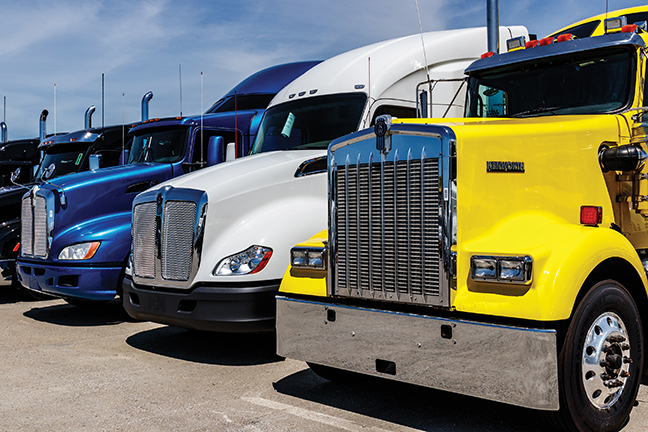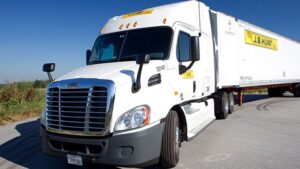In March, U.S. sales of Class 8 trucks achieved a spectacular rebound from February results with sales of 22,512 units, according to data received from ACT Research. It was the best sales month since December 2019, and the second-best March since 2006 when massive “pre-buying” took place as owners avoided new engine requirements from the U.S. Environmental Protection Agency (EPA) that went into effect for 2007.
Compared with February 2021 sales of 15,727, sales in March increased by a whopping 43.1%. A large part of that increase is attributable to February sales being suppressed by “Uri.” That’s the name given by the National Weather Service to the polar vortex event that wreaked havoc on much of the U.S. at mid-month. Snow and ice caused the shutdown of highways, and massive power outages in Texas and other states closed businesses for days, severely disrupting the freight cycle.
Because of this, March sales were enhanced by “a little pent-up demand from the sales that did not happen due to February’s ugly weather,” according to Kenny Vieth, president and senior analyst at ACT.
Sales were up 33.3% from the 16,892 units sold in March 2020. Weather did not have an impact on that increase, but the economy did.
“Compared to last year, you have to remember that in the first quarter of 2020, the Class 8 market was still overcapacitated,” Vieth said. “There were just too many trucks chasing too little freight.”
Of the new Class 8 tractors sold, 16,631 (73.9%) were road tractors compared to 5,881 (26.1%) destined for vocational uses such as dump, trash, concrete or other uses.
While sales climbed substantially, orders for new Class 8 trucks on the North American market fell by 9.4% from February, with 40,049 orders recorded for March compared to 44,200 in February. Compared with last March, when just 7,600 orders were placed, orders increased by a whopping 427%. Those orders have resulted in a backlog of 237,700 trucks waiting to be built.
“At March’s build rate, that’s about 9.4 months,” Vieth explained.
The March bump in sales does not dispel predictions of production slowdowns due to parts shortages, especially semiconductors. A number of parts and materials are in short supply.
“If it wasn’t about semiconductors, it would be about steel,” said Vieth, explaining that the parts and materials suppliers the industry relies on take time to ramp up, too. For example, to increase truck production, the plant supplying the axles has to increase production, and the mill supplying steel for the axles, and the mine supplying the ore to make the steel.
There are similar supply-chain woes for other components, too. As each supplier ramps up production, lag time is built into the system. A lot of things need to happen for truck builders to increase production.
In an April 15 blog post, Don Ake, vice president of commercial vehicles for FTR, explained it this way:
“Unfortunately, the restarts in many industries have been difficult. Manufacturers had to install COVID safety protocols. Workers have been reluctant to return to jobs either based on personal health concerns or generous government assistance. The result is surging demand combined with pent-up demand, matched up against constricted supply.”
Like automobile manufacturers, several OEMs announced at least temporary shutdowns during the month of April due to parts shortages.
Unions play a role, too. On April 16, members of the United Auto Workers went on strike at Volvo Truck’s New River Valley plant in Dublin, Virginia, after an extension of the current labor agreement expired. The strike is not expected to spread to other Volvo or Mack facilities, as the New River Valley plant is under a separate contract. However, workers at other locations will undoubtedly be watching for the results of the work stoppage in Dublin.
As for new truck prices, increases or potential surcharges are a possibility. While no official announcement has been made as of press time, market conditions are favorable.
Used Class 8 truck sales rose in March according to ACT, by 29% over February numbers and by 31% over March 2020 sales. Average unit prices rose by 6%, while the average odometer reading and age both dropped.
Trailer orders also rose, with more than 29,500 new trailers ordered in March, a 12% increase over February orders and more than three times the orders placed in March 2020.
All of the major truck manufacturers experienced increased U.S. Class 8 sales in March, according to data received from Wards Intelligence. Freightliner’s 8,839 topped the list, a 41.5% increase over February sales and 47.7% better than March 2020.
Peterbilt was next with sales of 3,181, an increase of 36.2% from February and 41.6% better than March 2020 sales numbers.
PACCAR sibling Kenworth sold 3,040 Class 8 trucks in March, 42.6% more than in February and 11.9% more than in March 2020.
Volvo experienced the largest increase of the big builders in terms of percentage with sales of 2,474, up 54.0% from February sales of 1,607 and 44.1% higher than March 2020 sales.
Mack’s 1,663 trucks sold topped February sales by 38.2% and bested March 2020 sales by 16.3%.
International rebounded with sales of 2,294, an increase of 51.0% over February sales of 1,519. Compared with March 2020, sales increased by 21.6%.
Western Star sales of 570 were a 64.3% improvement from February sales of 347 and 9.2% better than the 522 sold last March.
For the year to date, Freightliner holds 41.2% of the U.S. Class 8 market with sales of 22,371 trucks. Peterbilt follows with sales of 8,269 (15.2%), followed by Kenworth with 7,040 sold for 13.0%. Next is Volvo with 10.7% of sales volume from 5,827 units moved, followed by International with 10.1%. Mack trails with 7.2% of the market, while Western Star brings up the rear with 2.5%.
Although truck sales are expected to remain strong in coming months, availability of parts will likely suppress manufacturing and the backlog of units waiting to be built isn’t likely to begin shrinking any time soon.
Those who are interested in purchasing a new or late-model used Class 8 truck aren’t likely to benefit by waiting.
Cliff Abbott is an experienced commercial vehicle driver and owner-operator who still holds a CDL in his home state of Alabama. In nearly 40 years in trucking, he’s been an instructor and trainer and has managed safety and recruiting operations for several carriers. Having never lost his love of the road, Cliff has written a book and hundreds of songs and has been writing for The Trucker for more than a decade.








